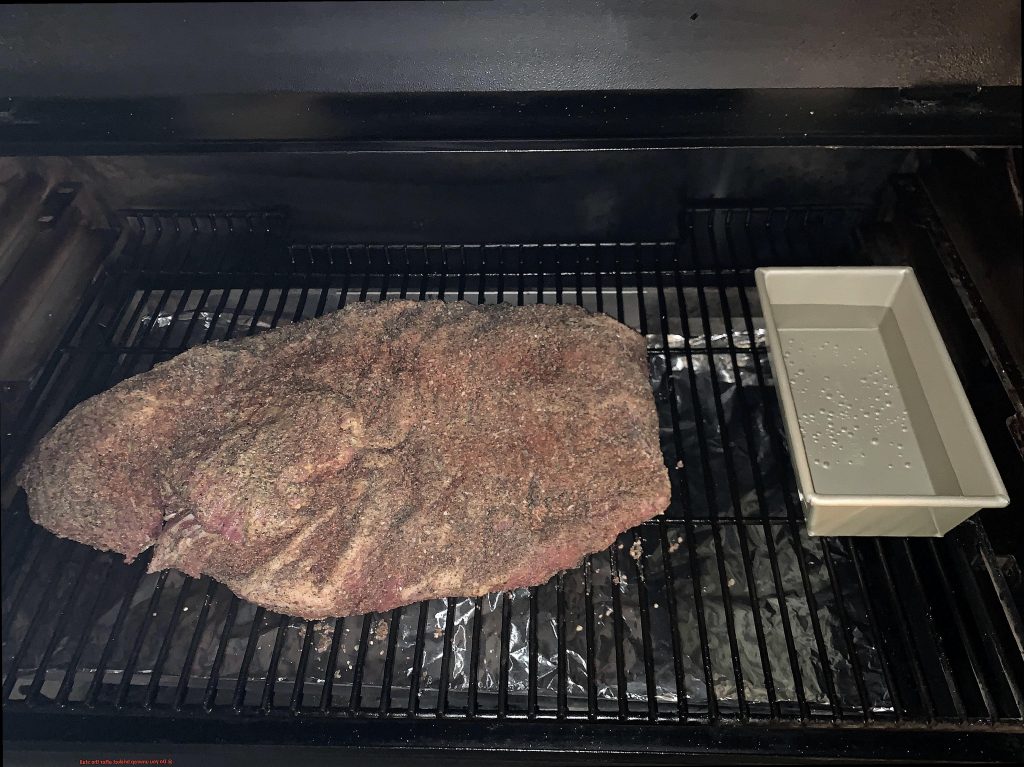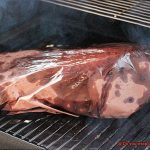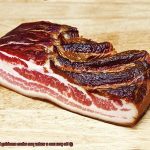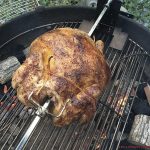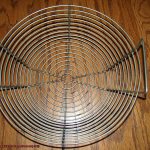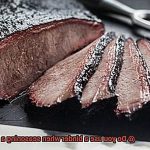Smoking a brisket is an art form that requires patience, skill, and a whole lot of love. As the meat slowly cooks over low heat, it develops a smoky flavor that’s hard to resist. But just when you think you’ve got it all figured out, the internal temperature of the meat hits a plateau, causing “the stall.”
If you’re wondering what to do after the stall, you’re not alone. Many barbecue enthusiasts and pitmasters debate whether to leave the brisket wrapped in foil or butcher paper throughout the entire cooking process. So, do you unwrap brisket after the stall or leave it wrapped until serving time?
The answer isn’t straightforward. Unwrapping your brisket after the stall can create a crispy bark and allow for more smoke penetration. However, leaving it wrapped can help retain moisture and prevent dryness.
In this blog post, we’ll examine both sides of the argument and explore different wrapping methods’ impact on your final product. Whether you’re an experienced pitmaster or a backyard smoker, we’ll help you decide on the best approach for your next brisket cookout.
Contents
Advantages of Unwrapping Brisket After the Stall
Smoking brisket is a true art form, but it can be a daunting task for even the most experienced pitmasters. One of the biggest challenges is dealing with the stall, a frustrating phenomenon where the internal temperature of the meat plateaus, delaying the cooking process for several hours. Luckily, there’s a technique that many pitmasters swear by to help push past the stall – unwrapping your brisket.
Unwrapping your brisket after the stall can have several advantages that can take your smoked meat to new heights.
Firstly, it can help you achieve a better bark on your meat. The bark is the dark, flavorful crust that forms on the outside of your brisket when exposed to smoke and heat.
When you unwrap your brisket, the bark will have a chance to firm up and develop a deeper color and flavor that is sure to impress even the pickiest of eaters.
Secondly, unwrapping your brisket can improve its texture. By exposing your meat to direct heat, you’re helping to break down tough collagen and fat, resulting in a more tender and juicy final product that will melt in your mouth with every bite. This is especially important if you want to avoid disappointing your guests with dry or chewy brisket.
Lastly, unwrapping your brisket can shorten your cooking time. When you hit the stall, your meat may take hours to reach its target temperature. By removing the foil or paper, you’re essentially giving your brisket a boost of heat that accelerates the cooking process.
This can be especially beneficial if you’re cooking for a large group or trying to meet an important deadline.
Of course, like any cooking technique, there are some potential downsides to unwrapping your brisket after the stall. For example, if you’re not careful, you could end up drying out your meat or overcooking it.
Additionally, some pitmasters argue that wrapping your brisket throughout the entire cooking process is essential for achieving a consistent texture and flavor. However, with some trial and error, you can find the perfect balance that works for you and your taste buds.
Disadvantages of Unwrapping Brisket After the Stall
Smoking brisket is an art that requires patience, technique, and a little bit of experimentation. One common stage in this process is the stall, where the internal temperature of the meat reaches a plateau or even decreases for several hours.
To combat this, many people choose to wrap their brisket with foil or butcher paper to help accelerate the cooking process and prevent the meat from drying out. However, some argue that unwrapping the brisket after the stall can lead to better results.
While it may be tempting to try this unwrapping technique, there are several disadvantages to consider. Firstly, unwrapping your brisket too early can cause it to dry out quickly. During the stall, moisture inside the meat is being redistributed and evaporated, which can result in a dry exterior. Wrapping helps trap in some of this moisture, while unwrapping can cause it to escape more quickly. This can lead to a tougher, drier brisket that is less enjoyable to eat.
Secondly, unwrapping your brisket can result in a longer cooking time. By wrapping the brisket during the stall, you are essentially steaming the meat and accelerating the cooking process. Unwrapping it can slow down this process and extend the overall cooking time, which can be frustrating if you’re trying to serve your guests on time.
Finally, unwrapping your brisket too early can cause it to lose its flavor and tenderness. The stall is an important part of the cooking process where connective tissue breaks down and becomes more tender. Unwrapping too early can interrupt this process and result in a tougher, less flavorful brisket.
How to Monitor Internal Temperature During a Stall
Smoking a brisket is no easy feat, and the stall can make it even more challenging. This plateau in temperature can last for several hours, leaving pitmasters frustrated and eager to serve their delicious smoked brisket. Here are five tips on how to monitor the internal temperature during a brisket stall.
Use a Meat Thermometer for Accuracy
A meat thermometer is the most accurate way to monitor the internal temperature of your brisket. Insert it into the thickest part of the meat, avoiding bones or fat, for an accurate reading. This will help you determine when it’s time to wrap or unwrap the brisket and avoid any undercooking or overcooking issues.
Use a Probe Thermometer for Convenience
A probe thermometer is another helpful tool for monitoring the internal temperature during the stall. It allows you to send continuous readings of the internal temperature to a remote receiver without opening the smoker and releasing heat. This method is convenient and ensures that you don’t miss any crucial temperature changes.
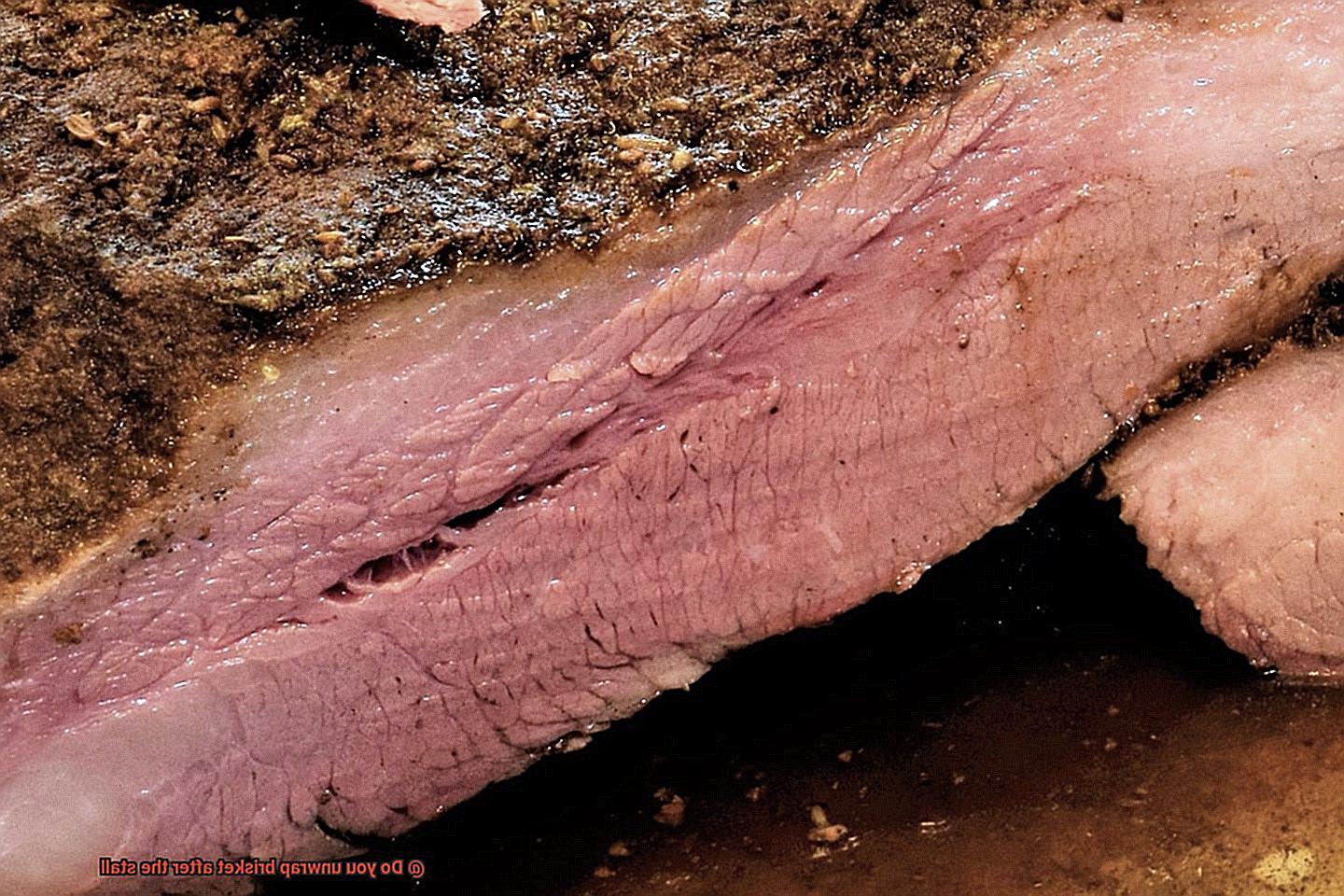
Wrap Your Brisket for Moisture Retention
Wrapping your brisket in foil or butcher paper can help retain moisture and speed up the cooking process. If you choose to wrap your brisket, make sure to unwrap it once it reaches an internal temperature of 160-170°F to allow for bark formation on the outside of the meat. This method can result in a more tender brisket but may sacrifice some smoke flavor.
Don’t Unwrap Your Brisket for a Crispier Bark
If you prefer a crispier bark or do not want to wrap your brisket, do not unwrap it during the stall. Instead, be patient and continue monitoring the internal temperature until it reaches 195-203°F for slicing or 205-210°F for shredding. This method may result in less moisture retention but allows for more smoke flavor penetration and a crispier bark.
Be Patient and Avoid Heat Loss
The stall can be frustrating, but it’s essential to be patient during this time. Minimize opening the grill or smoker too often as this can cause heat loss and extend the stall. Follow proper temperature guidelines and let the stall run its course for a perfectly cooked piece of meat.
Tips for Unwrapping and Wrapping Brisket During a Stall
Brisket is a classic barbecue dish that requires time, patience, and a bit of know-how to perfect. One of the biggest obstacles in achieving a tender, juicy brisket is the stall, where the meat’s internal temperature plateaus despite continued cooking.
Wrapping the brisket in foil or butcher paper during the stall has become a popular technique known as the Texas Crutch, but whether or not to unwrap the brisket after the stall is still up for debate among grill experts. Here are some tips for wrapping and unwrapping your brisket during a stall to help you achieve the perfect cook every time.
To wrap or not to wrap?
The decision to wrap your brisket during the stall ultimately comes down to personal preference. Wrapping helps to capture and retain moisture, which is crucial for breaking down tough connective tissue and achieving a tender brisket. However, some argue that unwrapping the brisket can result in a more flavorful and smokier meat.
Wrapping during the stall
If you decide to wrap your brisket during the stall, there are some tips to keep in mind.
First, make sure that the meat is fully coated in rub or seasoning before wrapping it. This will enhance its flavor and create a nice crust on the outside.
Secondly, wrap the brisket tightly in foil or butcher paper to prevent any air from getting in and drying out the meat. Finally, place the wrapped brisket back on the grill with the fat cap facing up to allow for even cooking.
Unwrapping after the stall
If you choose to unwrap your brisket after the stall, be prepared to monitor and adjust your cooking method accordingly. Unwrapping the brisket can cause a significant drop in temperature, so make sure you have a plan for how you will maintain the temperature of your smoker or grill.
Also, consider spritzing your brisket with a water or apple juice mixture before rewrapping it to help keep it moist while still allowing for some evaporation.
Patience is key
Whether you choose to unwrap or keep your brisket wrapped, be patient and let the stall run its course for a perfectly cooked piece of meat. Unwrapping the brisket too soon can cause it to dry out and lose flavor, while unwrapping it too late can prolong the cooking time. Remember to experiment with different methods to find what works best for you.
How Long Does the Stall Last?
The stall. A dreaded moment for any brisket-griller. After hours of carefully tending to your meat, the temperature stops rising, and you’re left wondering if you’ve done something wrong. Fear not, my friend. This is just the stall, a crucial part of the brisket cooking process. But how long does it last?
Unfortunately, there’s no easy answer. The stall’s duration can vary from 2 to 8 hours or more, depending on various factors. The size and thickness of your brisket can play a significant role in how long the stall lasts. A larger and thicker brisket will require more time to cook and may experience a more prolonged stall than a smaller one.
Additionally, the cooking temperature affects the stall’s duration. Lower temperatures mean slower cooking times, which can result in a longer stall. Humidity and airflow in your cooking environment also play a part. If you’re cooking in a humid environment with poor airflow, it can take longer for moisture to evaporate from your brisket’s surface, leading to a more extended stall.
But fear not. Wrapping your brisket in foil or butcher paper after the stall can help trap moisture and reduce evaporation. This can speed up cooking time and shorten the stall’s duration. However, wrapping too early can cause your brisket to become steamed rather than smoked, so be careful.
Factors That Affect the Length of a Stall
If you’re a fan of cooking brisket, you know that the “stall” can be one of the most frustrating parts of the process. But did you know that there are several factors that can affect the length of a stall? Let’s dive in and explore these factors.
First up is size. A larger and thicker brisket will take longer to cook than a smaller one, which means it’s more likely to experience a longer stall. So if you’re cooking a big brisket, don’t be surprised if it takes some extra time to get through that plateau.
Next, let’s talk about cooking method. Cooking your brisket over direct heat or at too high a temperature can cause it to cook too quickly, resulting in a shorter stall. However, cooking low and slow over indirect heat is more likely to result in a longer stall. So if you’re looking for that perfect bark and tender meat, take it slow and steady.
Finally, humidity and temperature can also play a role. A dry environment can cause moisture to evaporate from the brisket at a faster rate, resulting in a shorter stall. But cooking in a more humid environment may cause moisture to remain on the surface of the meat, resulting in a longer stall. So if you’re struggling with a lengthy stall, take a look at your cooking conditions and adjust accordingly.
What to Do When You Reach the Plateau Temperature
Smoking a brisket is an art form that requires patience and skill. However, even the most experienced pitmasters will encounter the dreaded plateau temperature during their cooking process. The plateau is when the internal temperature of the meat plateaus, and it can be frustrating to wait for it to push through. But fear not, as there are several things you can do to make the process smoother.
Don’t Unwrap Prematurely
One of the biggest mistakes novice smokers make is unwrapping their brisket prematurely in an attempt to speed up the cooking process. However, this can cause it to dry out and become tough. When you unwrap the brisket, you expose it to air and heat, which can cause it to lose moisture. So instead of unwrapping, let it cook at its own pace.
The Texas Crutch
To help speed up the process, consider wrapping your brisket in foil or butcher paper once you hit the plateau temperature. This technique is known as the Texas Crutch and helps retain moisture and heat, which can help push through the stall. However, be aware that this technique can affect the bark or crust on the brisket by making it softer.
Personal Preference
Whether or not you should unwrap your brisket after the stall is up to personal preference and desired outcome. If you’re looking for a crispy bark on your brisket, then leaving it wrapped can hinder that result. Wrapping traps moisture from the meat and causes the bark to become soft.
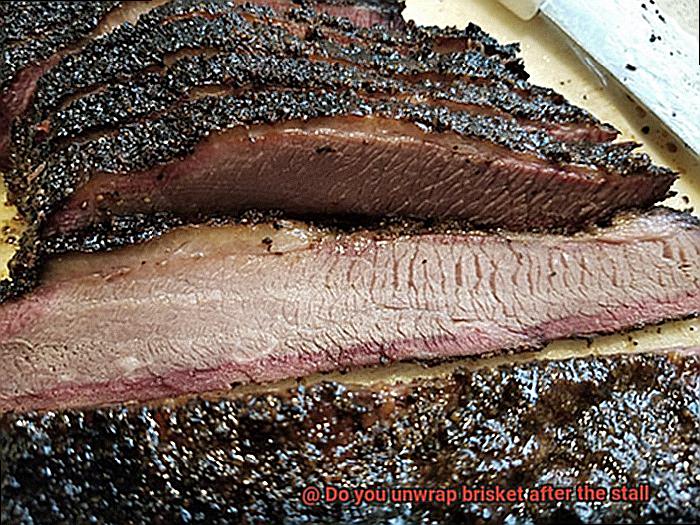
However, if you want a more tender and moist brisket, wrapping it in foil or butcher paper after the stall can help retain moisture and prevent it from drying out.
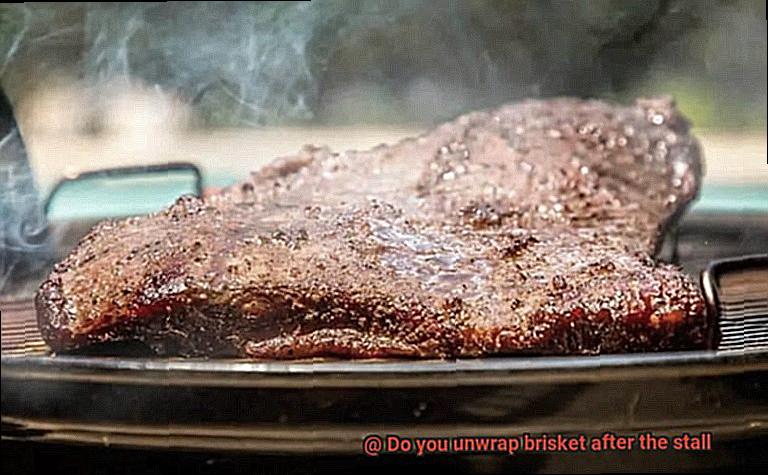
Spritzing and Mopping
If you choose to unwrap your brisket after reaching the plateau temperature, consider spritzing it with apple juice or a marinade to prevent it from drying out.
Additionally, you could mop your brisket with a mixture of vinegar and spices to add flavor and moisture.
Other Considerations When Deciding Whether to Unwrap or Not
Smoking a brisket is more than just cooking – it’s an art form. The decision to unwrap or not unwrap your brisket after the stall is a personal one, and there are several factors to consider when making this decision. Here are some additional considerations to keep in mind:
First up, let’s talk about bark development. The bark is that delicious crust that forms on the outside of your brisket, and it’s what gives it that irresistible texture. If you’re looking for a thicker, crunchier bark, then leaving your brisket unwrapped during the cooking process may be the way to go. By exposing your brisket to more smoke and heat, you can achieve that perfect texture that’ll have your guests begging for more.
Next, let’s talk about smoke flavor. If you’re a fan of that pronounced smoky flavor in your brisket, then leaving it unwrapped during the cooking process can help achieve that. The longer your brisket is exposed to the smoke, the more flavor it will absorb, resulting in a mouth-watering taste that’ll have you reaching for seconds.
But what about moisture content? Depending on how you like your brisket, keeping it wrapped can help retain moisture and create a tender final product. On the other hand, unwrapping your brisket can result in a drier end result. It all comes down to personal preference – do you want a juicy brisket or a drier one?
Cook time is another consideration to keep in mind. Wrapping your brisket can speed up the cooking process by creating a more efficient environment, while unwrapping it may extend the cook time. So if you’re short on time, wrapping may be the way to go.
However, there are also some other factors to consider when deciding whether to unwrap or not. For example, if you’re cooking in inclement weather or need to transport your brisket, wrapping it can help protect it from the elements and keep it hot. Additionally, wrapping your brisket can help prevent it from getting too dark or burnt on the outside.
P3uxKyshonE” >
Conclusion
After much research and experimentation, the answer to whether or not you should unwrap brisket after the stall is not a simple one. It ultimately depends on personal preference and desired outcome. While some pitmasters swear by leaving the brisket wrapped during the entire cooking process, others argue that unwrapping it after the stall allows for a better bark and texture.
Regardless of which method you choose, it’s important to monitor the internal temperature of your brisket and make adjustments as needed. Remember to let your brisket rest before slicing into it, allowing the juices to redistribute throughout the meat for maximum flavor.
In conclusion, there is no right or wrong answer when it comes to unwrapping brisket after the stall. It’s all about finding what works best for you and your taste buds.

